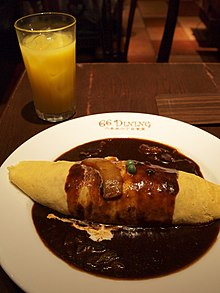Omu-raisu

Omu-rice (オムライス Omu-raisu?) ou Omurice é um exemplo de Yoshoku (um estilo de culinária do Japão influenciado pelo Ocidente]][1]), consistindo de um omelete feito com arroz frito e normalmente coberto com ketchup.[2][3] Com omu e raisu sendo contrações das palavras omelete e arroz em inglês,[4] o nome é um exemplo de wasei-eigo. É um prato popular comumente feito em casa e frequentemente encontrado em restaurantes de estilo ocidental no Japão. O prato foi levado para a Coreia durante a ocupação japonesa no país,[5] e hoje é um elemento de menus de restaurantes de gimbap por toda a Coreia do Sul, onde é conhecido como "오므라이스 (omeuraiseu)" em hangul.[6] O omu-raisu é também popular em Taiwan, outro território antigamente ocupado pelo Japão. As crianças, em particular, gostam do omu-raisu, e ele é muitas vezes oferecido nas refeições infantis.[1]
Fala-se que o omu-raisu foi criado por volta da virada do século XX[4] em um restaurante de estilo ocidental no distrito de Renga-tei, Ginza, Tóquio, inspirado pelo chakin-zushi.[7]
Variações
[editar | editar código-fonte]
O prato normalmente consiste de chikin raisu (chicken rice: arroz frito na panela com ketchup e frango) enrolado em uma camada fina de ovo frito. Os ingredientes do recheio variam. Muitas vezes o arroz é frito com várias carnes (mas normalmente frango) e/ou vegetais, e pode ser recheada com caldo de carne, ketchup, demi-glace, molho branco ou simplesmente sal e pimenta. Algumas vezes, o arroz é substituído por macarrão frito (yakisoba) e se transforma em um omusoba. Uma variante em Okinawa é o omutako, consistindo de um omelete sobre taco rice. Hotdog frito e spam também são duas carnes populares incluídas no prato.
Referências
- ↑ a b "Omuraisu (ou omurice ou omu rice, omelete de arroz japonês", JustHungry.com.
- ↑ Nishimoto, Miyoko (June 1992). "Beyond Sushi: Japanese Cooking in the Great Home-Style Tradition", Vegetarian Times, No. 178. Predefinição:Issn.
- ↑ Paxton, Norbert (2008). The Rough Guide to Korea, p.249. ISBN 978-1-4053-8420-9.
- ↑ a b Shimbo, Hiroko (2000). The Japanese Kitchen, p.148. ISBN 1-55832-177-2.
- ↑ Sohn, Ho-min (2006). Korean language in culture and society, p.59. ISBN 9780824826949.
- ↑ Gail Jennings (Outubro de 2005). «Shokudo - An Unlikely Marriage of Comfort Foods». hawaiidiner.com. Consultado em 27 de setembro de 2014. Arquivado do original em 31 de outubro de 2010
- ↑ Kishi Asako (March 15, 2002). "NIPPONIA No.20: Omuraisu", Web-Japan.org.
Text is available under the CC BY-SA 4.0 license; additional terms may apply.
Images, videos and audio are available under their respective licenses.
